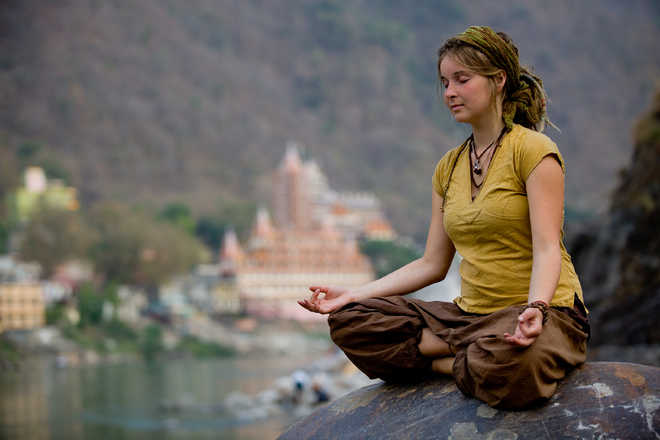Dr Satish K Kapoor
Meditation or dhyana, the seventh limb of Ashtanga Yoga of Patanjali, is preceded by abstentions (yama), moral observances (niyama), physical postures (asana), breath control (pranayama), withdrawal of the senses from their objects (pratyahara), and contemplation (harana). It culminates in the state of trance, called samadhi.
While dharana, the sixth limb of Yoga, requires that mind should be tagged to a single object, whether external, like a tangible image or form bestowed with holiness, or internal, like a psychic centre (chakra-s) in the subtle body, dhyana is focusing the mind till subject and object become one. Concentration is made on the spiritual centre located between the eyebrows (ajna chakra), tip of tongue or nose, the palate, the thumbs of hands and feet, or the inner sound (nada) and light (jyoti), to turn consciousness towards god. While practicing dharana, careful, deliberate and systematic effort is made to sustain focus. However, the focus becomes natural and spontaneous (sahaja) with practice, during dhyana. When dharana transmutes into dhyana, the spiritual seeker visualizes, before his mind’s eye, the object of focus, without looking at it.
According to the Yoga Sutras of Patanjali (III.2), dhyana is ‘an unbroken flow of thought toward the object of concentration.’ It can be nishkala or sakala. In the former, the seeker (sadhaka) focuses on the all-pervasive reality internally; in the latter, he can focus on saguna (with attributes) and nirguna (attributeless) forms of God, alternately.
Dhyana may be preceded by prayer, listening to holy words or passages (shabda), hymns in praise of god (kirtana) or of one’s chosen deity (ishta deity), repetition of the divine name (nama- japa), and remembrance of it (nama-simaran), to create a conducive mental environment for spiritual journey. Dhyana is perfected when the power of feeling (bhavana shakti), power of thinking (chintana shakti) and power of action (kriya shakti), coalesce to reach the state of unitary consciousness, in which the knower (jnata), knowledge (jnana) and the object of knowledge (jneya) become one. This is called samadhi. In the Gherand Samhita (shashthopadesha), the sage Gheranda instructs his disciple Chandakapali, that dhyana is of three types: sthula, jyotirmaya and sukshma.
Sthula dhyana, gross meditation, is absorptive contemplation on a divine form, more specifically, the image of personal god (ishtadeva), or that of one’s religious preceptor (guru), entrenched in one’s being.
Jyotirmaya dhyana, effulgent meditation, is focusing on the individual soul (jivatma) or on the supreme Self, radiating light (tejomaya brahma) in the cavity of the heart. With practice, the sadhaka is able to see flashes of light in the primal sound (pranavatmaka jyoti), reverberating within him. Sometime, focus is made on luminous objects, like the flame of a candle or an earthen lamp (diya), or on the sun, moon or a star, as advised by the spiritual teacher.
Sukshma dhyana, subtle meditation, is made on something abstract, like a sacred syllable (mantra), geometrical form (yantra), inner music (nada), the vital being (prana), or the serpent power (kundalini shakti) that lies coiled up at the base of the spinal column. It is best performed in shambhavi mudra, with eyes half-open, and focused within.
According to Gheranda Samhita, jyoirmaya dhyana is a hundred times better than sthula dhyana, and sukshma dhyana a million times better than jyotirmaya dhyana. As dhyana reaches its summum bonum, the seeker discovers in his body, the entire universe. Yogis believe that the inner cosmos (brahmanda) lies on the royal road (maha marga) from the tongue (jihva) to the hollow place in the crown of the head, called brahmarandhra, or dashma dvara (tenth door’). Kundalini-shakti is active in this region. Gheranda suggests that the seeker should be totally absorbed in the meditative process for divine experience.
The Chhandogya Upanishad (chapter VII.6.1-2) says that meditation comes naturally to the earth, the intermediate space, the heaven, waters, mountains, gods and human beings. It advises: ‘meditate on meditation’. But the range of meditation goes as far as the range of an object of meditation. The point has been explained thus:
‘Anyone who meditates on name as Brahman (Absolute Reality), acquires freedom of movement as far as the range of name extends. Speech is verily greater than name. So he who meditates on speech … acquires freedom of movement as far as the range of speech extends. Mind is greater than speech. Anyone who meditates on the mind… gets freedom of movement as far as the range of the mind extends. Will indeed is greater than the mind. He who meditates on will… gets freedom of movement as far as the range of will extends. Intelligence indeed is greater than will. He who meditates on intelligence … attains the world as attainable by intelligence. Meditation is indeed greater than intelligence. He who meditates on meditation as Brahman gets freedom of movement as far as the range of meditation extends. Understanding is greater than meditation. He who meditates on understanding …wins the worlds possessed of understanding and knowledge.’ And so on.
But he who meditates on the omniscient Self by using the pathways of truth, understanding, reflection, faith, and the like, discovers that the self-existent Universal Reality is not outside but within him. The Aitreya Aranayaka (II.2.4.6) says: tad yo’ham so’sau,yo’sau so’ham – ‘What I am that he is; what he is that am I’.
(Dr Satish K Kapoor, former British Council Scholar, and former Registrar, DAV University, is a noted author, educationist, historian and spiritualist based in Jalandhar City)
Unlock Exclusive Insights with The Tribune Premium
Take your experience further with Premium access.
Thought-provoking Opinions, Expert Analysis, In-depth Insights and other Member Only Benefits
Already a Member? Sign In Now










